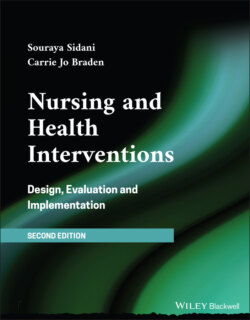Читать книгу Nursing and Health Interventions - Souraya Sidani - Страница 13
1.1 TREATMENT DECISION‐MAKING
ОглавлениеHealth professionals (i.e. practitioners, clinicians, therapists) include nurses, physicians, psychologists, dietitians, health educators, and allied health therapists such as respiratory, physical, occupational, and speech‐language therapists. They work independently and collaboratively to provide high‐quality healthcare to individuals, families, and communities (hereafter collectively referred to as clients) in a range of settings such as primary, home, acute, rehabilitation, and long‐term care.
Provision of high‐quality healthcare aims to: promote health; prevent and manage health problems; prevent complications; and maintain or improve well‐being. Currently, person‐, patient‐, or client‐centered care is viewed as the cornerstone of high‐quality care (Van Belle et al., 2019), and client participation in treatment decisions and in health management as the pillar of client‐centered care (Britten et al., 2017). Client participation is enacted in shared decision‐making. Shared decision‐making is an interactive process that involves collaboration between clients and health professionals, focused on making treatment decisions (Stacey & Légaré, 2015). The application of shared decision‐making in practice involves several steps (Coutu et al., 2015; Elwyn et al., 2014; Muscat et al., 2015; Shay & Lafata, 2014):
1 Health professionals conduct a comprehensive and thorough assessment of clients' condition. The assessment covers all domains of health, including biophysiological, physical, cognitive, emotional, behavioral, sociocultural, and spiritual domains, as well as the clients' personal account of the health problem and its impact on their life.
2 Health professionals critically analyze the findings of the assessment and, together with the clients, formulate the clients' health needs, that is, the potential (i.e. at risk) and actual health problems with which clients present and requiring remediation; in addition health professionals work with clients to prioritize their problems. An in‐depth and lucid understanding of the clients' health problems is necessary for selecting the remediation interventions.
3 Health professionals appraise alternative interventions; discuss with the clients the benefits and risks of the interventions; elicit clients' preferences for interventions; and collaboratively select the most appropriate, effective, and safe ones.
4 Health professionals deliver the selected interventions for, on behalf, or with clients.
5 Health professionals and clients monitor clients' status on a regular basis to determine the extent to which the interventions were successful in addressing clients' health problems. If unsuccessful, health professionals and clients investigate factors that may influence the effectiveness of the interventions and should be accounted for in adapting the same interventions or providing alternative ones.
The application of decision‐making in practice requires a sound theoretical and empirical knowledge base of the health problem and the interventions. This implies that health professionals have access to:
1 A conceptualization of the health problem with which clients present. The conceptualization clarifies the nature of the problem; specifies its indicators; presents a comprehensive list of its determinants experienced in different domains of health and at different levels (e.g. interpersonal, environmental); and delineates the relationships between the health problem and other co‐occurring problems, which are likely to be observed with the increasing prevalence of multiple chronic conditions, particularly among older adults (Golfam et al., 2015). The conceptualization helps health professionals understand the clients' health problem and overall condition, which, in turn, guides the search for relevant interventions.
2 A conceptualization of alternative (if available) interventions addressing the same health problems. The conceptualization describes the components and activities comprising each intervention, and explains its mechanism of action (i.e. why and how the interventions work in addressing the health problem). This conceptualization is important for understanding the interventions and for adapting them to the clients' context or life circumstances (Levinton, 2017). Health professionals find it difficult to apply interventions they do not understand (Kazdin, 2007).
3 Empirical evidence that indicates the extent to which each alternative intervention is effective and safe in addressing the health problem, as well as its relative effectiveness (i.e. compared to other interventions).
Empirical evidence on the effectiveness of interventions has been regarded as a credible source to inform health professionals' practice and to guide decision‐making. It forms the foundation of evidence‐based practice.
